Please read the important information regarding these games at the bottom of the page.
The discovery of the molecular structure of DNA - the double helix
A scientific breakthrough
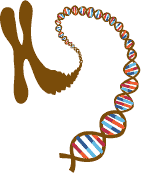
The sentence "This structure has novel features which are of considerable biological interest" may be one of science's most famous understatements. It appeared in April 1953 in the scientific paper where James Watson and Francis Crick presented the structure of the DNA-helix, the molecule that carries genetic information from one generation to the other.
Nine years later, in 1962, they shared the Nobel Prize in Physiology or Medicine with Maurice Wilkins, for solving one of the most important of all biological riddles. Half a century later, important new implications of this contribution to science are still coming to light.
What is DNA?
The work of many scientists paved the way for the exploration of DNA. Way back in 1868, almost a century before the Nobel Prize was awarded to Watson, Crick and Wilkins, a young Swiss physician named Friedrich Miescher, isolated something no one had ever seen before from the nuclei of cells. He called the compound "nuclein." This is today called nucleic acid, the "NA" in DNA (deoxyribo-nucleic-acid) and RNA (ribo-nucleic-acid).
 |
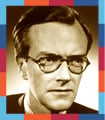 |
| Francis Crick and James
Watson, 1953. Photo: Cold Spring Harbor Laboratory Archives |
Maurice Wilkins. |
Two years earlier, the Czech monk Gregor Mendel, had finished a series of experiments with peas. His observations turned out to be closely connected to the finding of nuclein. Mendel was able to show that certain traits in the peas, such as their shape or color, were inherited in different packages. These packages are what we now call genes.
For a long time the connection between nucleic acid and genes was not known. But in 1944 the American scientist Oswald Avery managed to transfer the ability to cause disease from one strain of bacteria to another. But not only that: the previously harmless bacteria could also pass the trait along to the next generation. What Avery had moved was nucleic acid. This proved that genes were made up of nucleic acid.
Solving the puzzle
In the late 1940's, the members of the scientific community were aware that DNA was most likely the molecule of life, even though many were skeptical since it was so "simple." They also knew that DNA included different amounts of the four bases adenine, thymine, guanine and cytosine (usually abbreviated A, T, G and C), but nobody had the slightest idea of what the molecule might look like.
In order to solve the elusive structure of DNA, a couple of distinct pieces of information needed to be put together. One was that the phosphate backbone was on the outside with bases on the inside; another that the molecule was a double helix. It was also important to figure out that the two strands run in opposite directions and that the molecule had a specific base pairing.
As in the solving of other complex problems, the work of many people was needed to establish the full picture.
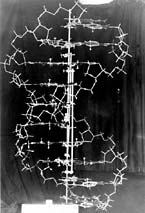 |
The original DNA model by
Watson and Crick. Photo: Cold Spring Harbor Laboratory Archives |
Using X-rays to see through DNA
Watson and Crick used stick-and-ball models to test their ideas on the possible structure of DNA. Other scientists used experimental methods instead. Among them were Rosalind Franklin and Maurice Wilkins, who were using X-ray diffraction to understand the physical structure of the DNA molecule.
When you shine X-rays on any kind of crystal – and some biological molecules, such as DNA, can form crystals if treated in certain ways – the invisible rays bounce off the sample. The rays then create complex patterns on photographic film. By looking at the patterns, it is possible to figure out important clues about the structures that make up the crystal.
 |
"Photograph 51". X-ray
diffraction photo of a DNA molecule, structure B. Photo: Cold Spring Harbor Laboratory Archives |
A three-helical structure?
The scientist Linus Pauling was eager to solve the mystery of the shape of DNA. In 1954 he became a Nobel Laureate in Chemistry for his ground-breaking work on chemical bonds and the structure of molecules and crystals. In early 1953 he had published a paper where he proposed a triple-helical structure for DNA. Watson and Crick had also previously worked out a three-helical model, in 1951. But their theory was wrong.
Their mistake was partly based on Watson having misremembered a talk by Rosalind Franklin where she reported that she had established the water content of DNA by using X-ray crystallographic methods. But Watson did not take notes, and remembered the numbers incorrectly.
Instead, it was Franklin's famous "photograph 51" that finally revealed the helical structure of DNA to Watson and Crick in 1953. This picture of DNA that had been crystallized under moist conditions shows a fuzzy X in the middle of the molecule, a pattern indicating a helical structure.
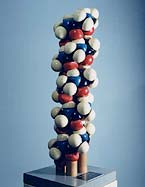 |
Model of the alpha helix, 1951. Photo: Oregon State University's Special Collections |
Specific base-pairing
The base-pairing mystery had been partly solved by the biochemist Erwin Chargoff some years earlier. In 1949 he showed that even though different organisms have different amounts of DNA, the amount of adenine always equals the amount of thymine. The same goes for the pair guanine and cytosine. For example, human DNA contains about 30 percent each of adenine and thymine, and 20 percent each of guanine and cytosine.
With this information at hand Watson was able to figure out the pairing rules. On the 21st of February 1953 he had the key insight, when he saw that the adenine-thymine bond was exactly as long as the cytosine-guanine bond. If the bases were paired in this way, each rung of the twisted ladder in the helix would be of equal length, and the sugar-phosphate backbone would be smooth.
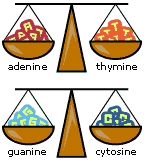
Structure shows action
"It has not escaped our notice that the specific pairing we have postulated immediately suggests a possible copying mechanism for the genetic material" wrote Watson and Crick in the scientific paper that was published in Nature, April 25, 1953.
This was indeed a breakthrough in the study of how genetic material passes from generation to generation. Once the model was established, its mere structure hinted that DNA was indeed the carrier of the genetic code and thus the key molecule of heredity, developmental biology and evolution.
The specific base pairing underlies the perfect copying of the molecule, which is essential for heredity. During cell division, the DNA molecule is able to "unzip" into two pieces. One new molecule is formed from each half-ladder, and due to the specific pairing this gives rise to two identical daughter copies from each parent molecule.
We all share the same building blocks
 DNA is a winning formula for
packaging genetic material. Therefore almost all
organisms – bacteria, plants, yeast and animals
– carry genetic information encapsulated as
DNA. One exception is some viruses that use RNA
instead.
DNA is a winning formula for
packaging genetic material. Therefore almost all
organisms – bacteria, plants, yeast and animals
– carry genetic information encapsulated as
DNA. One exception is some viruses that use RNA
instead.
Different species need different amounts of DNA. Therefore the copying of the DNA that precedes cell division differs between organisms. For example, the DNA in E. coli bacteria is made up of 4 million base pairs and the whole genome is thus one millimeter long. The single-cell bacterium can copy its genome and divide into two cells once every 20 minutes.
The DNA of humans, on the other hand, is composed of approximately 3 billion base pairs, making up a total of almost a meter-long stretch of DNA in every cell in our bodies.
In order to fit, the DNA must be packaged in a very compact form. In E. coli the single circular DNA molecule is curled up in a condensed fashion, whereas the human DNA is packaged in 23 distinct chromosome pairs. Here the genetic material is tightly rolled up on structures called histones.
A new biological era
This knowledge of how genetic material is stored and copied has given rise to a new way of looking at and manipulating biological processes, called molecular biology. With the help of so-called restriction enzymes, molecules that cut the DNA at particular stretches, pieces of DNA can be cut out or inserted at different places.
In basic science, where you want to understand the role of all the different genes in humans and animals, new techniques have been developed. For one thing, it is now possible to make mice that are genetically modified and lack particular genes. By studying these animals scientists try to figure out what that gene may be used for in normal mice. This is called the knockout technique, since stretches of DNA have been taken away, or knocked out.
Scientists have also been able to insert new bits of DNA into cells that lack particular pieces of genes or whole genes. With this new DNA, the cell becomes capable of producing gene products it could not make before. The hope is that, in the future, diseases that arise due to the lack of a particular protein could be treated by this kind of gene therapy.
Was Rosalind Franklin nominated?
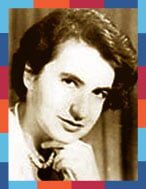 |
Rosalind Franklin. Photo: Cold Spring Harbor Laboratory Archives |
Many voices have argued that the Nobel Prize should also have been awarded to Rosalind Franklin, since her experimental data provided a very important piece of evidence leading to the solving of the DNA structure. In a recent interview in the magazine Scientific American, Watson himself suggested that it might have been a good idea to give Wilkins and Franklin the Nobel Prize in Chemistry, and him and Crick the Nobel Prize in Physiology or Medicine – in that way all four would have been honored.
Rosalind Franklin died in 1958. As a rule only living persons can be nominated for the Nobel Prize, so the 1962 Nobel Prize was out of the question. The Nobel archives, at the Nobel Prize-awarding institutions, that among other things contain the nominations connected to the prizes, are held closed. But 50 years after a particular prize had been awarded, the archives concerning the nominees are released. Therefore, in 2008 it was possible to see whether Rosalind Franklin ever was a nominee for the Nobel Prize concerning the DNA helix. The answer is that no one ever nominated her - neither for the Nobel Prize in Physiology or Medicine nor in Chemistry.
The DNA-helix
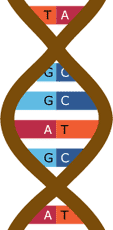 |
 |
| The sugar-phosphate backbone is on the outside and the four different bases are on the inside of the DNA molecule. | |
The two strands of the double helix are anti-parallel, which means that they run in opposite directions.
The sugar-phosphate backbone is on the outside of the helix, and the bases are on the inside. The backbone can be thought of as the sides of a ladder, whereas the bases in the middle form the rungs of the ladder.
Each rung is composed of two base pairs. Either an adenine-thymine pair that form a two-hydrogen bond together, or a cytosine-guanine pair that form a three-hydrogen bond. The base pairing is thus restricted.
This restriction is essential when the DNA is being copied: the DNA-helix is first "unzipped" in two long stretches of sugar-phosphate backbone with a line of free bases sticking up from it, like the teeth of a comb. Each half will then be the template for a new, complementary strand. Biological machines inside the cell put the corresponding free bases onto the split molecule and also "proof-read" the result to find and correct any mistakes. After the doubling, this gives rise to two exact copies of the original DNA molecule.
The coding regions in the DNA strand, the genes, make up only a fraction of the total amount of DNA. The stretches that flank the coding regions are called introns, and consist of non-coding DNA. Introns were looked upon as junk in the early days. Today, biologists and geneticists believe that this non-coding DNA may be essential in order to expose the coding regions and to regulate how the genes are expressed.
By Lotta Fredholm, Science Journalist
| READ MORE | PLAY A GAME | ||||||||||
|
|
||||||||||
First published 30 September 2003
MLA style: "The discovery of the molecular structure of DNA - the double helix". Nobelprize.org. Nobel Prize Outreach AB 2022. <http://nobel-external-educationalgames-app.azurewebsites.net/educational/medicine/dna_double_helix/readmore.php>